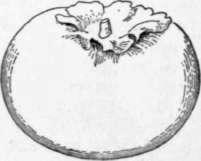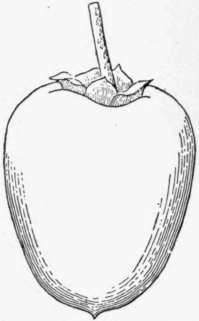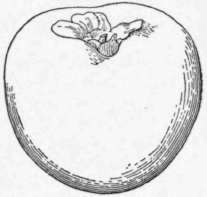Japanese Persimmon Group Of Pollination Constants
Description
This section is from the book "Manual Of Tropical And Subtropical Fruits", by Wilson Popenoe. Also available from Amazon: Manual Of Tropical And Subtropical Fruits.
Japanese Persimmon Group Of Pollination Constants
Costata. - Form conical, pointed, somewhat four-angled in transverse section; size medium, length 2 5/8 inches, thickness 2 1/8 inches; surface salmon-yellow; flesh light yellow, dark-colored flesh or seeds seldom occurring; flavor astringent until the fruit is fully ripe, then sweet and pleasant. Ripening season very late.
Tree distinctive in appearance and a rapid erect grower. It does not produce staminate flowers in Florida. The fruit is remarkable for its good keeping qualities.
Fuyugaki (Fig. 47).- Form oblate; size medium-large, length about 2 inches, thickness about 2 3/4 inches; base with sometimes four creases extending outward from the stem, the calyx reflexed in the ripe fruit; apex depressed, with smooth, regular, shallow basin; surface deep orange-red in color; skin thin, tough; flesh firm, meaty when ripe, deep carrot-orange in color, with minute, widely scattered dark specks; flavor sweet, with no as-tringency even in the unripe fruit; seeds 3/4 inch long, few.
Recently introduced from Japan by the United States Department of Agriculture. Hume says: "It keeps well, and in quality is one of the best. We believe this variety will surpass all other Japan persimmons so far introduced as a market fruit. It can be placed on the market while still hard, and can be eaten without waiting for the fruit to soften."

Fig. 47. The Fuyugaki kaki. (X about 1/2)
Hachiya (Fig. 48). - Form oblong-conical, with a short point at the apex; size very large, length 3 3/4 inches, thickness 3 1/4 inches; surface bright orange-red, with occasional dark spots and rings near the apex; flesh deep yellow, sometimes having a few dark streaks in it; flavor astringent until the fruit is fully ripe, then rich and sweet; seeds present. Ripens midseason to late.
Tree vigorous in growth, with a tendency to bear fruit in alternate years. It does not produce staminate flowers in Florida. The fruit is large and handsome. Said to be one of the principal varieties used in Japan for drying.
Ormond. - Form conical; size small to medium, length 2 5/8 inches, thickness 1 7/8 inches; base rounded, with the calyx reflexed ; apex sharp, not creased, or only slightly so; surface smooth, bright orange-red, covered with a thin bloom; skin thin, tough; flesh orange-red, meaty, or jelly-like in the fully ripe fruit; seeds large, long, pointed. Ripening season late (December in Florida).
A fruit of good quality, and one which keeps well.
Tamopan. - Form broadly oblate with a constriction around the middle; size large, weight sometimes 16 ounces, diameter 3 to 5 inches; surface smooth, orange-red in color; skin tough and rather thick; flesh meaty, light colored; flavor astringent until the fruit is fully ripe, then rich and sweet; seedless. Introduced from China by the United States Department of Agriculture. The tree is a strong, upright grower.
Tane-nashi (Fig. 49). - Form roundish conical, very symmetrical; size large to very large, length 3 1/3 inches, thickness 3 3/8 inches; surface very smooth, light yellow to bright orange-red; flesh yellow, soft; flavor sweet and pleasant; seedless. Ripens early.

Fig. 48. The Hachiya kaki. (X 1/2)

Fig. 49. The Tane-nashi kaki, one of the principal varieties used in Japan for the production of dried kakis, and now grown commercially in the United States. (X about 1/2)
The tree is vigorous, prolific, and self-fertile, but it has shown a tendency in California to bear in alternate years. Extensively used in Japan for drying and considered a valuable market variety in the United States. Perhaps the most highly esteemed of the light-fleshed kinds.
Triumph. - Form oblate; size medium; surface yellowish to deep orange-red; skin thick; flesh yellowish red, translucent, soft and juicy; flavor astringent until the fruit is fully ripe, when it becomes sweet and pleasant; seedless or with as many as 5 to 8 seeds. Ripens in Florida from September to December.
The tree does not produce staminate flowers in Florida. A fruit of good quality, recommended for home use and for market.
Tsuru. - Form slender, pointed; size large, length 3 3/8 inches, thickness 2 3/8 inches; surface bright orange-red; flesh orange-yellow; flavor astringent until the fruit is fully ripe, when it becomes sweet and pleasant. Ripens very late.
Tree vigorous and productive, but does not produce staminate flowers in Florida.
Continue to:


